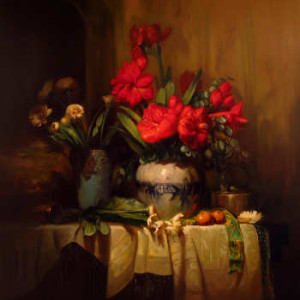
40×40 inches, Oil on Linen
© Margret E. Short, OPA, AWAM
I read about PRONK in Still Lifes: Techniques and Style , and it really didn’t give any specific meaning of the word. It actually was used as a description for a certain style of painting. It was not in the book’s glossary or index. After searching six or seven other still life and painting technique books, I was still at a loss. Wikipedia and all the other on-line dictionary sites yielded nothing also. My huge Reader's Digest Great Encyclopedia Dictionary includes an English to Dutch section, but this was also a dead-end.
Over the past couple of weeks, I have been in contact with the Rijksmuseum working out some technical aspects of my project. I suddenly thought, "why not go right to the source?" I immediately sent off an email to the Registrar's Office and received an response right away.
The description of pronk from the Rijksmuseum states, "pronk stilleven or pronk schilderij which means something like showpiece still-life, an extraordinary piece with an image extremely difficult to paint. Silver, grapes covered with dew, lemons, glassware and so on."
It made perfect sense. If you will picture in your mind's eye, the sumptuous still lifes depicting tables laid with crisp white linen filled with stemware, compotes, lobsters, and flowers. Many have silver, brass, gold, platters, fruit, brocades, tassels, and just about anything you can think of that might be in a Dutch household. This is PRONK.
The image posted here is a painting I did last year. It is not one of the Lessons from the Low Countries pieces, but is an example of the PRONK style of painting. Amaryllis measures 40×40 and has some of the same components which would qualify.
There are several sumptuous still lifes in the Rembrandt and the Golden Age of Dutch Art Exhibition. Paintings by Pieter Claesz, Jan Jansz van de Velde, and Abraham Mignon are all good examples.
If any readers of this blog have any more information about PRONK please post a comment.

Art critic Ken Johnson for the New York Times today (August 10, 2012)uses the word “pronk” in his review of the Dutch artist Willem van Aelst exposition currently at the National Gallery. Apparently van Aelst uses the word in many painting titles. Johnson describes “pronk” as “things of conspicuous expense that only the wealthy could afford.” The entire article is very enlightening for a deeper understanding of this word.